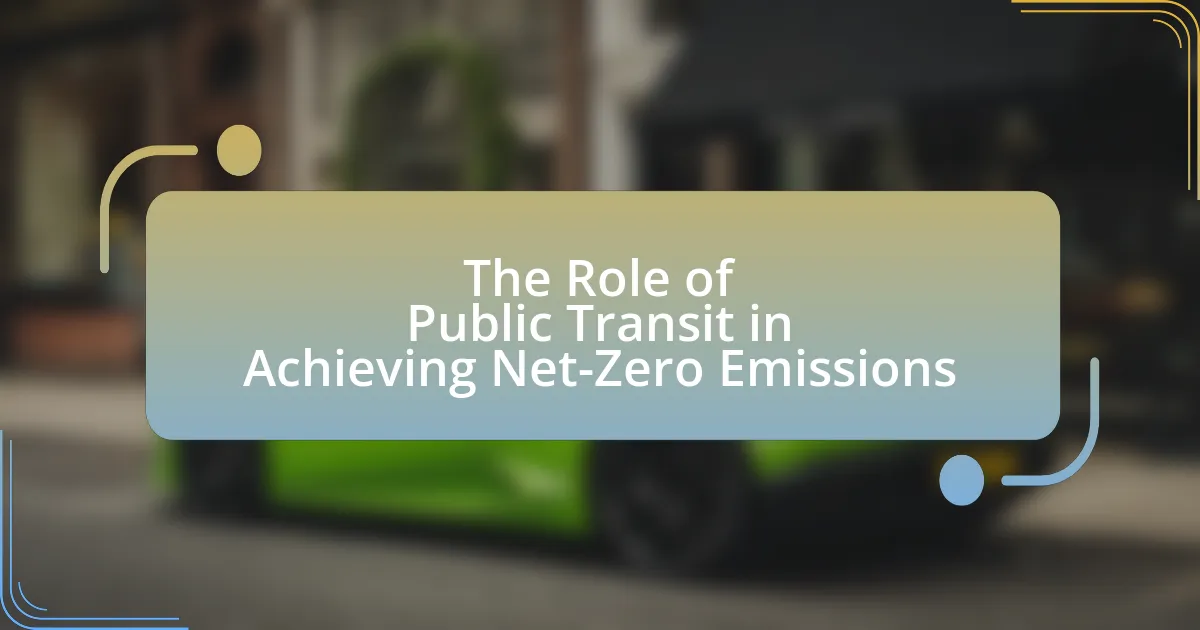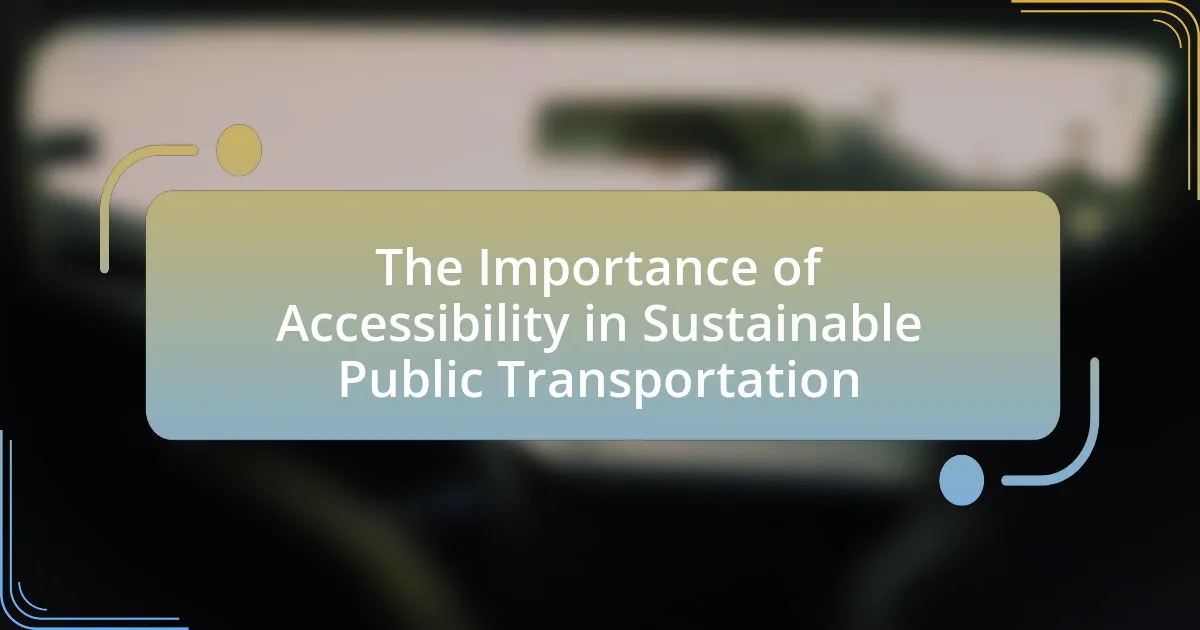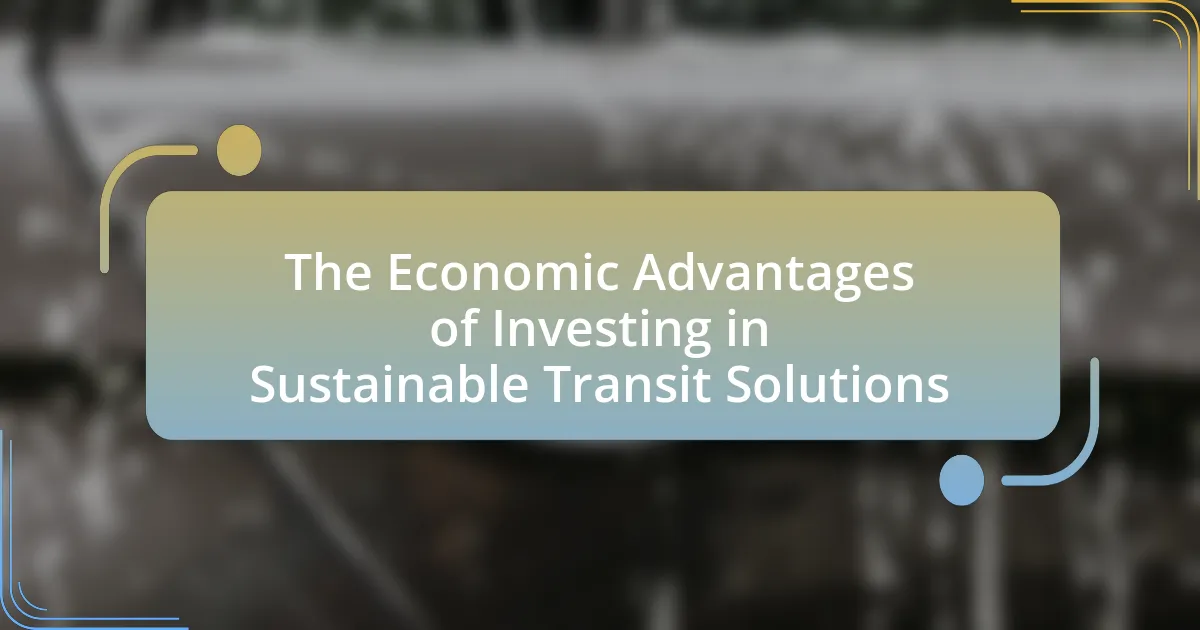Electric buses are vehicles powered by electric motors and batteries, designed to enhance urban public transportation while significantly reducing greenhouse gas emissions and improving air quality. This article explores the role of electric buses in urban environments, highlighting their advantages over traditional diesel buses, including lower operational costs and reduced noise pollution. It examines the technologies that enable electric buses, the economic and environmental benefits they provide, and the challenges cities face in their implementation, such as infrastructure needs and battery limitations. Additionally, the article discusses future trends, including advancements in technology and the integration of smart city initiatives, which are crucial for the successful adoption of electric buses in urban transport systems.

What are Electric Buses and Their Role in Urban Environments?
Electric buses are vehicles powered by electric motors and batteries, designed to transport passengers in urban settings. Their role in urban environments includes reducing greenhouse gas emissions, improving air quality, and decreasing noise pollution compared to traditional diesel buses. According to the International Council on Clean Transportation, electric buses can reduce emissions by up to 70% in urban areas, contributing significantly to sustainable public transportation initiatives. Additionally, cities implementing electric bus fleets often experience lower operational costs due to reduced fuel and maintenance expenses, further enhancing their viability as a public transport solution.
How do Electric Buses differ from Traditional Buses?
Electric buses differ from traditional buses primarily in their power source; electric buses are powered by electricity stored in batteries, while traditional buses typically rely on diesel or gasoline engines. This fundamental difference leads to several key distinctions: electric buses produce zero tailpipe emissions, contributing to improved air quality in urban environments, whereas traditional buses emit greenhouse gases and pollutants. Additionally, electric buses tend to have lower operating costs due to reduced fuel expenses and maintenance requirements, as electric drivetrains have fewer moving parts compared to internal combustion engines. Furthermore, electric buses are generally quieter, enhancing the overall urban experience by reducing noise pollution. These differences highlight the potential of electric buses to transform public transportation in cities, aligning with sustainability goals and improving urban living conditions.
What technologies are used in Electric Buses?
Electric buses utilize several key technologies, including electric drivetrains, lithium-ion batteries, regenerative braking systems, and advanced telematics. Electric drivetrains replace traditional internal combustion engines, providing efficient power delivery and reducing emissions. Lithium-ion batteries are the primary energy storage solution, offering high energy density and rapid charging capabilities, which are essential for urban transit. Regenerative braking systems capture energy during braking, enhancing overall efficiency by converting kinetic energy back into stored electrical energy. Advanced telematics systems enable real-time monitoring of bus performance, route optimization, and maintenance scheduling, contributing to improved operational efficiency and service reliability.
How do Electric Buses impact urban air quality?
Electric buses significantly improve urban air quality by reducing harmful emissions. Unlike traditional diesel buses, electric buses produce zero tailpipe emissions, which directly decreases pollutants such as nitrogen oxides and particulate matter in urban areas. A study conducted by the Union of Concerned Scientists found that transitioning to electric buses can reduce greenhouse gas emissions by up to 70% compared to diesel buses, contributing to cleaner air and better public health outcomes. Additionally, cities that have implemented electric bus fleets, such as Los Angeles and Seattle, report noticeable improvements in air quality metrics, demonstrating the positive impact of electric buses on urban environments.
Why are Electric Buses becoming popular in cities?
Electric buses are becoming popular in cities primarily due to their environmental benefits and cost-effectiveness. These vehicles produce zero tailpipe emissions, significantly reducing air pollution and contributing to improved urban air quality. According to a report by the International Council on Clean Transportation, electric buses can reduce greenhouse gas emissions by up to 70% compared to diesel buses, depending on the energy source used for electricity generation. Additionally, electric buses have lower operating costs, as they are cheaper to maintain and fuel compared to traditional fossil fuel buses. This combination of environmental and economic advantages is driving cities to adopt electric buses as a sustainable public transportation solution.
What are the economic benefits of Electric Buses for urban transport?
Electric buses provide significant economic benefits for urban transport by reducing operational costs and enhancing public health. The lower cost of electricity compared to diesel fuel leads to substantial savings in fuel expenses; for instance, electric buses can save up to 70% on fuel costs. Additionally, electric buses have fewer moving parts, resulting in lower maintenance costs, which can be reduced by approximately 30% compared to traditional buses.
Moreover, the adoption of electric buses can lead to job creation in the green technology sector, as cities invest in infrastructure and maintenance facilities. A study by the International Council on Clean Transportation found that transitioning to electric buses could create over 100,000 jobs in the U.S. alone by 2030. Furthermore, the reduction in air pollution from electric buses can lead to lower healthcare costs associated with respiratory diseases, which can save cities millions annually.
These economic advantages demonstrate that electric buses not only contribute to environmental sustainability but also provide tangible financial benefits for urban transport systems.
How do Electric Buses contribute to sustainability goals?
Electric buses contribute to sustainability goals by significantly reducing greenhouse gas emissions and improving air quality in urban environments. Unlike traditional diesel buses, electric buses produce zero tailpipe emissions, which helps decrease urban air pollution and its associated health risks. According to the American Public Transportation Association, transitioning to electric buses can reduce carbon dioxide emissions by up to 70% compared to diesel buses, depending on the energy source used for electricity generation. Additionally, electric buses are often more energy-efficient, converting over 70% of electrical energy from the grid to power at the wheels, compared to only about 20% for diesel buses. This efficiency not only lowers operational costs but also supports the broader goal of reducing reliance on fossil fuels, thereby promoting a more sustainable urban transportation system.

What are the Challenges Facing Electric Buses in Urban Areas?
Electric buses in urban areas face several challenges, including limited charging infrastructure, high initial costs, and range anxiety. Limited charging infrastructure restricts the ability to recharge buses efficiently, leading to operational delays. High initial costs, often exceeding those of traditional buses, can deter transit agencies from adopting electric options despite long-term savings on fuel and maintenance. Range anxiety, the fear that electric buses will not complete their routes without running out of battery, further complicates their integration into existing transit systems. According to a report by the International Council on Clean Transportation, the upfront cost of electric buses can be 30% higher than diesel buses, which poses a significant barrier to widespread adoption.
What infrastructure is needed to support Electric Buses?
Electric buses require a robust infrastructure that includes charging stations, dedicated bus lanes, and maintenance facilities. Charging stations must be strategically located throughout urban areas to ensure accessibility and minimize downtime, with fast-charging capabilities to reduce the time buses spend off-route. Dedicated bus lanes enhance operational efficiency by allowing electric buses to avoid congestion, thereby improving service reliability. Additionally, maintenance facilities equipped with specialized tools and trained personnel are essential for the upkeep of electric bus technology, which differs from traditional diesel buses. This infrastructure is crucial for the successful integration of electric buses into urban transit systems, as evidenced by cities like Los Angeles and Shenzhen, which have implemented extensive charging networks and dedicated lanes to support their electric bus fleets.
How do charging stations affect the deployment of Electric Buses?
Charging stations significantly enhance the deployment of electric buses by providing the necessary infrastructure for their operation. The availability of charging stations directly influences the feasibility of electric bus routes, as buses require regular charging to maintain operational efficiency. For instance, cities with extensive charging networks can support longer routes and higher frequencies of electric bus services, thereby increasing their attractiveness to transit agencies and passengers. According to a report by the International Council on Clean Transportation, cities that have invested in robust charging infrastructure have seen a 30% increase in electric bus adoption rates. This correlation underscores the critical role that charging stations play in facilitating the transition to electric public transportation systems.
What are the limitations of current battery technology for Electric Buses?
Current battery technology for electric buses faces several limitations, primarily including limited energy density, long charging times, high costs, and environmental concerns regarding battery production and disposal. Limited energy density restricts the range of electric buses, often requiring more frequent charging or reducing passenger capacity. Long charging times can hinder operational efficiency, as many electric buses need to be charged for several hours, which is impractical for continuous service. High costs of advanced battery systems, such as lithium-ion batteries, can make electric buses less economically viable compared to traditional diesel buses. Additionally, environmental concerns arise from the mining of materials like lithium and cobalt, as well as the challenges associated with recycling used batteries, which can impact sustainability efforts in urban transportation.
How do cities address the challenges of Electric Bus implementation?
Cities address the challenges of electric bus implementation by investing in infrastructure, establishing supportive policies, and engaging in public-private partnerships. Infrastructure investments include the development of charging stations and maintenance facilities, which are essential for the operational efficiency of electric buses. For instance, Los Angeles has committed to installing over 1,000 charging stations to support its electric bus fleet. Supportive policies involve creating incentives for electric bus adoption, such as grants and subsidies, which help offset initial costs. Additionally, public-private partnerships facilitate collaboration between government entities and private companies, enabling shared resources and expertise. An example is the partnership between the City of Seattle and local utility companies to enhance charging infrastructure and energy management for electric buses. These strategies collectively help cities overcome the logistical, financial, and technical challenges associated with electric bus implementation.
What policies are being developed to support Electric Bus adoption?
Governments are developing various policies to support Electric Bus adoption, including financial incentives, infrastructure investments, and regulatory frameworks. For instance, many regions are implementing subsidies for electric bus purchases and operational costs, which can significantly reduce the financial burden on transit agencies. Additionally, policies are being established to enhance charging infrastructure, such as dedicated charging stations at depots and along bus routes, to ensure operational efficiency. Furthermore, regulatory measures are being introduced to set emissions targets that encourage the transition from diesel to electric buses, aligning with broader environmental goals. These initiatives are supported by studies showing that electric buses can reduce greenhouse gas emissions by up to 70% compared to traditional buses, thus validating the effectiveness of these policies in promoting sustainable urban transport.
How can public-private partnerships enhance Electric Bus infrastructure?
Public-private partnerships can enhance electric bus infrastructure by leveraging the strengths of both sectors to improve funding, technology, and operational efficiency. These collaborations can facilitate investment in charging stations, maintenance facilities, and fleet expansion, which are critical for the successful deployment of electric buses. For instance, a study by the International Council on Clean Transportation found that cities with public-private partnerships for electric bus deployment saw a 30% increase in infrastructure development speed compared to those relying solely on public funding. This acceleration is crucial for meeting urban mobility demands and reducing greenhouse gas emissions effectively.

What is the Future Outlook for Electric Buses in Urban Environments?
The future outlook for electric buses in urban environments is highly promising, driven by advancements in technology, increasing government support, and growing public demand for sustainable transportation. Electric buses are projected to comprise a significant portion of public transit fleets by 2030, with estimates suggesting that over 50% of new bus purchases in major cities will be electric. This shift is supported by initiatives such as the U.S. government’s commitment to invest $5 billion in electric bus infrastructure through the Bipartisan Infrastructure Law, aimed at reducing greenhouse gas emissions and improving air quality. Additionally, cities like Los Angeles and London are already implementing extensive electric bus networks, showcasing successful models for others to follow.
How will advancements in technology shape Electric Buses?
Advancements in technology will significantly enhance electric buses by improving battery efficiency, increasing range, and enabling smart connectivity features. For instance, the development of solid-state batteries can potentially double the energy density compared to current lithium-ion batteries, allowing electric buses to travel longer distances on a single charge. Additionally, the integration of artificial intelligence and IoT (Internet of Things) will facilitate real-time monitoring of bus performance and maintenance needs, optimizing operational efficiency. According to a report by the International Energy Agency, electric buses could reduce urban transport emissions by up to 70% by 2040, highlighting the transformative impact of these technological advancements on urban environments.
What role will autonomous driving play in the future of Electric Buses?
Autonomous driving will significantly enhance the efficiency and safety of electric buses in urban environments. By integrating advanced sensors and AI technology, autonomous electric buses can optimize routes, reduce traffic congestion, and improve energy consumption. For instance, a study by the International Transport Forum indicates that autonomous vehicles can increase public transport capacity by up to 30%, thereby making electric buses a more viable option for urban transit systems. Additionally, autonomous driving reduces the likelihood of human error, which is responsible for a substantial percentage of traffic accidents, thus promoting safer travel for passengers.
How can smart city initiatives integrate Electric Buses into urban transport?
Smart city initiatives can integrate electric buses into urban transport by developing dedicated charging infrastructure, implementing real-time data systems for route optimization, and promoting public-private partnerships. Dedicated charging stations ensure that electric buses can recharge efficiently, supporting their operational schedules. Real-time data systems enable the monitoring of bus performance and passenger demand, allowing for dynamic route adjustments that enhance service efficiency. Public-private partnerships can facilitate investment in electric bus fleets and infrastructure, leveraging resources from both sectors to accelerate deployment. For instance, cities like Los Angeles have successfully integrated electric buses by establishing extensive charging networks and collaborating with private companies for fleet management, demonstrating the effectiveness of these strategies.
What best practices can cities adopt for successful Electric Bus programs?
Cities can adopt several best practices for successful Electric Bus programs, including comprehensive planning, stakeholder engagement, and investment in charging infrastructure. Comprehensive planning involves assessing current transit needs and integrating electric buses into existing routes to maximize efficiency. Stakeholder engagement ensures that community needs and concerns are addressed, fostering public support and participation. Investment in charging infrastructure is critical; cities should establish strategically located charging stations to minimize downtime and ensure operational reliability. According to the American Public Transportation Association, cities that have implemented these practices have seen increased ridership and reduced operational costs, demonstrating the effectiveness of a well-structured approach to electric bus deployment.
How can cities effectively engage the community in Electric Bus initiatives?
Cities can effectively engage the community in Electric Bus initiatives by implementing inclusive public consultation processes and educational outreach programs. These initiatives allow residents to voice their opinions, ask questions, and understand the benefits of electric buses, such as reduced emissions and lower operational costs. For example, cities like Los Angeles have held community workshops and surveys to gather input on electric bus routes and features, ensuring that the initiatives align with community needs and preferences. Additionally, providing transparent information about the environmental impact and operational efficiency of electric buses can foster community support and participation.
What lessons can be learned from cities that have successfully implemented Electric Buses?
Cities that have successfully implemented electric buses demonstrate several key lessons: the importance of robust infrastructure, effective stakeholder engagement, and comprehensive planning. For instance, cities like Shenzhen, China, which transitioned its entire fleet to electric buses, highlight the necessity of investing in charging infrastructure to support operational efficiency. Shenzhen’s experience shows that having a well-planned network of charging stations can significantly reduce downtime and enhance service reliability.
Moreover, successful cities emphasize the need for collaboration among government agencies, manufacturers, and the community to ensure smooth implementation. In Los Angeles, stakeholder engagement has been crucial in addressing public concerns and securing funding, which underscores the value of transparency and communication in the transition process.
Finally, data from cities like Amsterdam indicates that integrating electric buses into existing public transport systems requires careful analysis of routes and schedules to maximize their effectiveness. This strategic planning can lead to improved air quality and reduced greenhouse gas emissions, reinforcing the environmental benefits of electric bus adoption.





